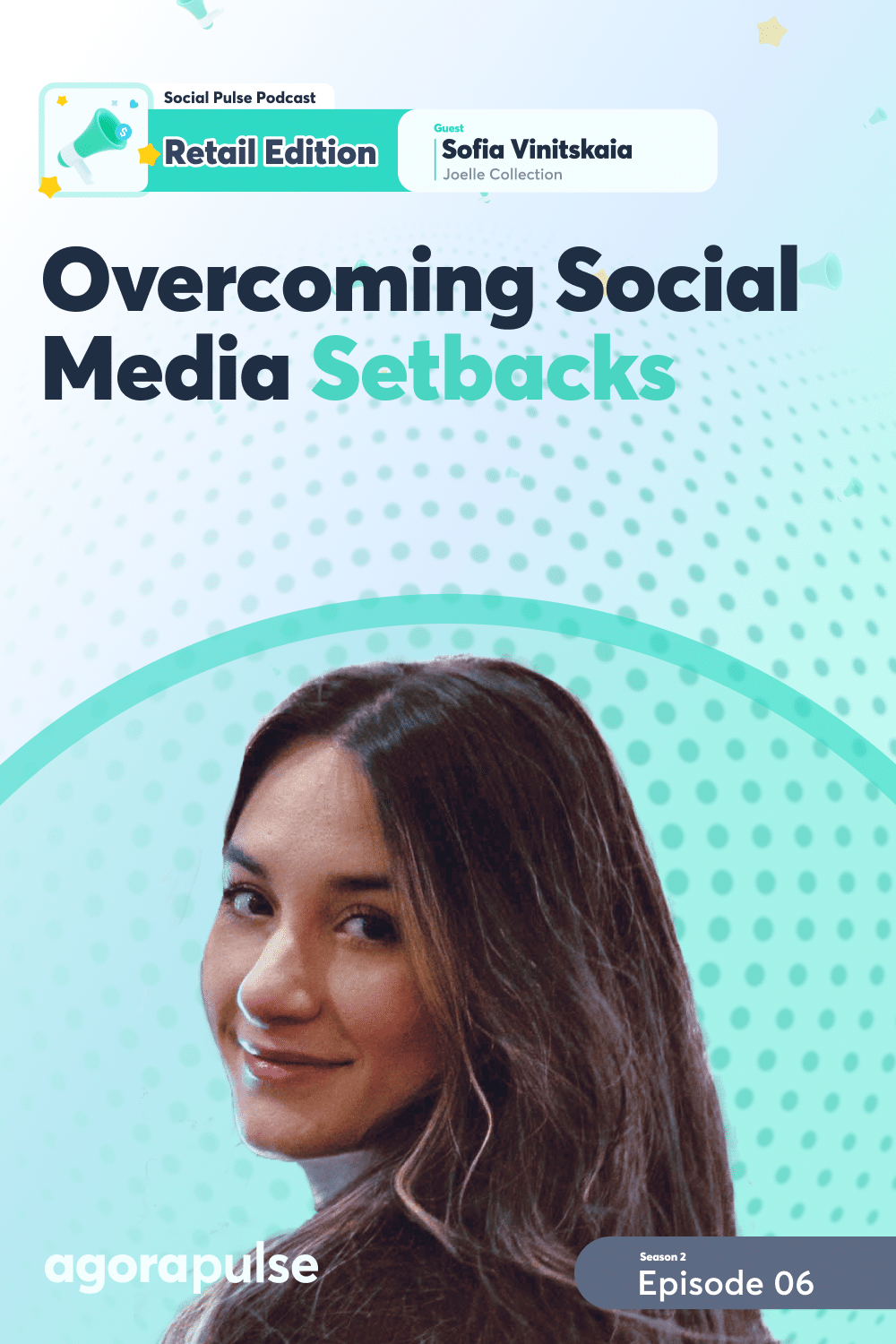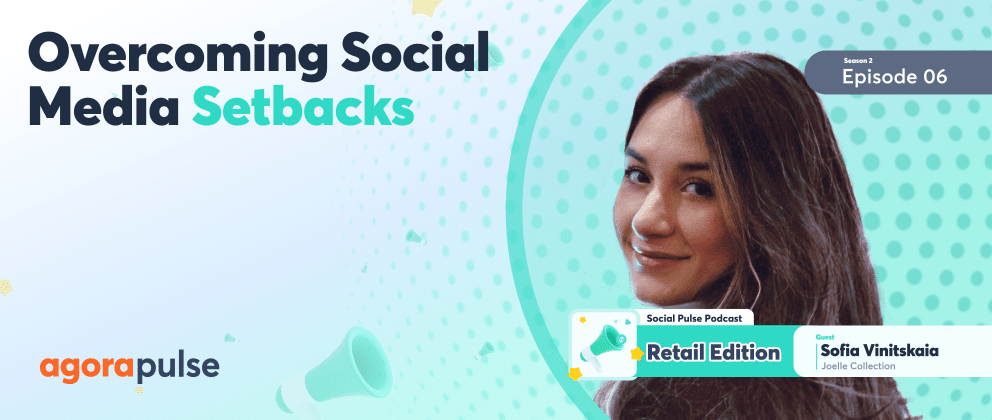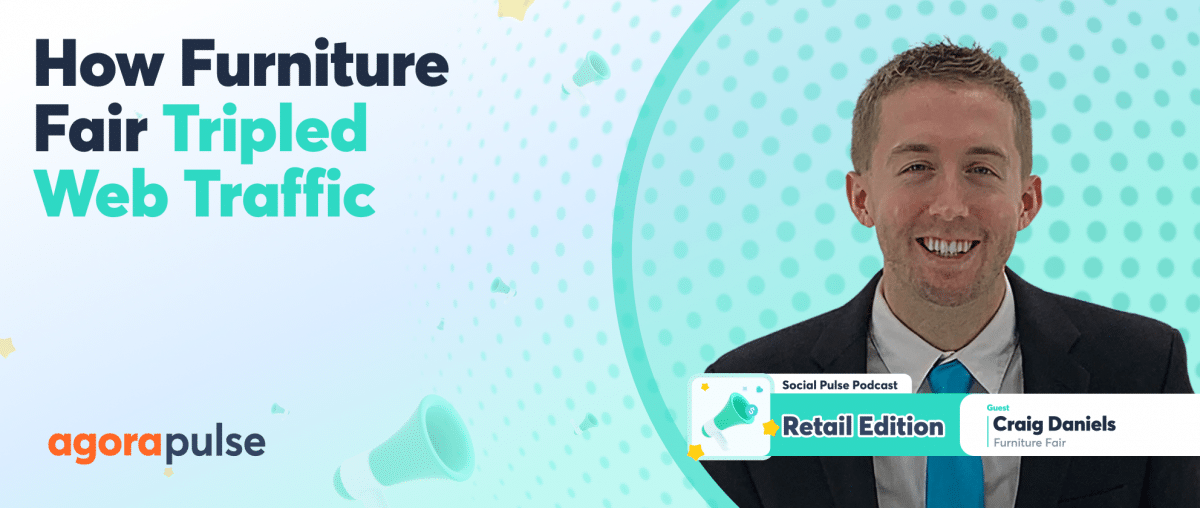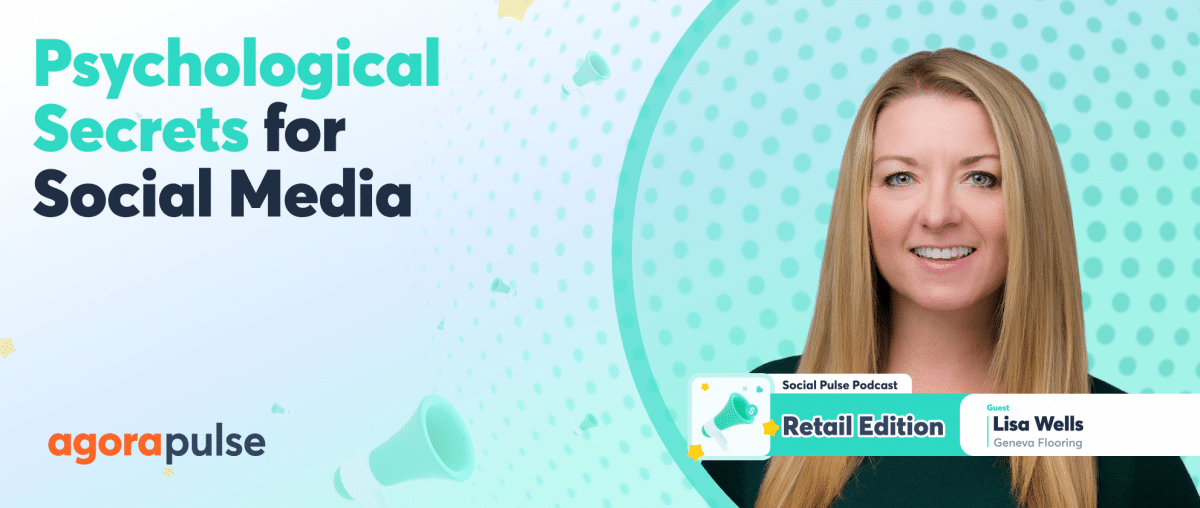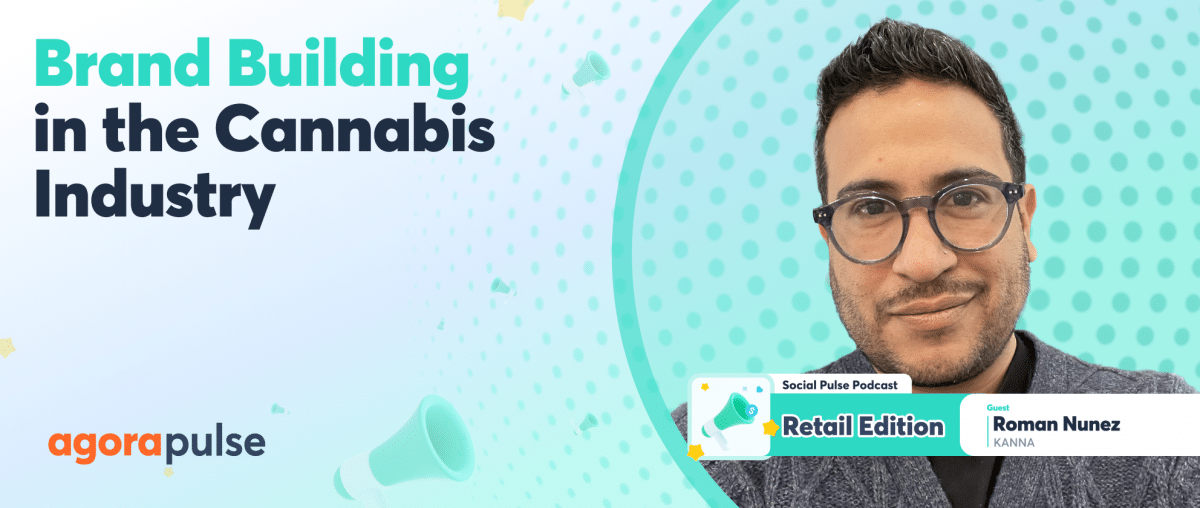If you’re a social media marketer in the retail sector, you know what it’s like to be frustrated by the ever-changing algorithms of social media. You’ve probably witnessed fluctuating engagement rates that left you scratching your head. Navigating those hurdles requires not just technical know-how but also patience, passion, and a bit of intuition.
Sofia Vinitskaia is no stranger to these challenges. As a marketing professional at Joelle Collection, Sofia has faced and conquered obstacles, from algorithm challenges and influencer content delays to the unprecedented disruptions caused by COVID-19. Her journey offers invaluable insights and lessons on turning social media challenges into marketing wins.
Listen to the Social Pulse Podcast: Retail episode hosted by Mike Allton or read on for the recap.
Talking Joelle Collection and Algorithms
Mike Allton: You could start by just telling us a bit about your role at Joelle and how you got into social media marketing.
Sofia Vinitskaia: What I do at Joelle Collection is: I’m their social media specialist, so I take care of everything that’s reporting, calendar strategies, planning, or coming up with creative ideas, researching influencers, restructuring if there’s something that we need to change, or if there are new KPIs that we should keep track of, or new trends that we should keep track of. It is my responsibility to be on top of everything when it comes to social media, if there’s a new platform, or if there’s a new trend.
Anything social media is basically what I touch upon when it comes to Joelle.
Mike Allton: Fantastic. We’re going to be talking about trends, and new platforms. But one of the things that I know is a challenge, because I faced it myself, is the algorithms; they’re different on every platform. They’re changing regularly. And they don’t tell us what’s happening. They don’t tell us how the algorithms are working.
How are you working through challenges with algorithms?
Sofia Vinitskaia: You know, it’s a really good question and I think there’s no good answer when it comes to an algorithm change.
I think that regardless of whether it’s going to change or not, I think the main priority is speaking to your community. So who are you speaking to? How are you speaking to them? Is the message connected to them?
And I think that’s the main strategy to have. Whether or not you’re a social media specialist or if you’re in the social media industry, I think that’s what you need to focus on.
“The algorithm will always change, and it doesn’t always make sense, and it’s not always explainable or even controllable by us.
Everything that we have to do is make sure that basically all of the content that we put up is quality content. And that’s something that’s important because being in the retail industry, you’ll have those people that will push on to the social media team to make sure that there’s content on a daily basis.
But sometimes the content is just not good. And you have to be able to take a step back and really evaluate, ‘What am I putting out there? Why am I putting it out there? And is it going to make sense to my brand, to who I’m speaking to?'”
I wish I could give you a magical answer and tell you that this is what I do, or here’s the key thing to do.
But I think truthfully, no matter what your brand is, your content is pushed to people who will be interested in your content. That’s the way an algorithm works. We also have to help with hashtags and things like that. But in general, the way that it’s pushed [is that it’s] pushed to people who enjoy or will potentially be prone to interacting with your content.
So I think quality and just making sure that what you’re putting out there is truthful to your brand and truthful to who you’re speaking to.
That’s the main key.
Saying “No” Sometimes
Mike Allton: I’m wondering if you could (obviously without naming names or anything like that) share an example of something where somebody came to you and said, “We want you to share this to social,” and you’re like, “I don’t think so.”
Sofia Vinitskaia: I think sometimes it could happen through a bunch of examples, but sometimes you could do a collaboration with the influencer, and what you discuss is not necessarily what you receive, which is okay, and it happens. Sometimes, it’s just a misunderstanding, but then you have to realize that that’s not the content I wanted to put out because that’s not what we discussed.
I can give you an example where we asked an influencer to make sure that it was the most recent collection because that’s what we were pushing. And they … snuck items that weren’t from our brand whatsoever.
Then you have to make the decision. What do you do? Because you do also have this contract. You did do an exchange for this, and now you have to reflect upon it. Is it worth me putting online? It is still a phase that is enjoyed by many, and that is true and respects our values as a brand. It is a perfect match when it comes to influencers, but the content is just not what we wanted, or sometimes it’s just you reflect upon a trend that maybe a funny trend came up and then you think, or everybody around you is telling you, “Oh, we should do it. It’s really interesting. It’s so funny. Everybody loves it.” But the trend is maybe not this same sense of humor that you carry on your brand.
You have to take a step back in and say, “Am I doing this for the right reasons?”
Going viral is one thing, but it doesn’t mean much if your content after that is not performing right. Or if you’re going viral but not to the right people. Then again, your message is not coming across because, okay, fine, you made somebody laugh or you created a little bit of a buzz, but truthfully, what is that doing for your brand?
I think that’s where you have to think about the strategy and think about what makes sense to you or your brand.
Increasing Engagement (Regardless of the Algorithm)
Mike Allton: Let’s talk about those for a second because I know in your work, in your experience, you’ve managed to increase engagement despite algorithm changes. And, obviously, you’re not just using trends to game the system.
What are some of those things that you’re doing? How have you managed to do that?
Sofia Vinitskaia: I think being in the retail industry, I can speak about products that we’re selling. So I think speaking about the product and the quality of the product, how the product is made, and the value of the brands—I think that’s something that I think we’ll come across regardless of the trends, regardless of the algorithm.
It comes back—or circles back—to the whole quality thing with content. I think, just again, addressing yourself to your clientele or who your customers are, who they could be like future customers, and making sure that the message that you’re portraying is the message that they want to hear and that you want to give them.
Let’s say [you’re] selling a T-shirt. The quality of the T-shirt is very important. Everybody sells T-shirts, right? It’s not special. But how do you present that T-shirt? What do you say about it? Or what is the image that you’re selling with the T-shirt? Or what is the history behind this T-shirt? And that’s how we were able to really make sure that our content remained on top. Quality, quality, quality is the keyword, I think.
Mike Allton: I’m hearing also some subtext here, which is that you’ve taken the time to understand your audience. You know what they care about. They care about the quality of the craftsmanship. They also care about value. Other things are values to them that align with the values of you and your business. And so you’re making sure that those come across in your social presence.
Influencer Marketing
You mentioned influencers earlier, and I want to come back to that because I work with influencers as well. I feel the pain because I’ve been there where you receive something from an influencer, and it’s not what you were looking for. And that’s hard. It’s hard to have to go back to an influencer and say, “I need you to redo this. I need you to redo this, this image, this scene.” (In my case, it’s often 30-minute presentations, which is super hard to say, “I need you to redo the whole thing.”)
How have you worked with or worked around or dealt with influencers that are late delivering what they promised?
Sofia Vinitskaia: You know what? It happens all the time, and it is something that you have to prepare for if you are going through the social media world. Sometimes, it could not even be the influencers’ fault. Sometimes, for example, if you send a package, did they not receive the package on time?
No matter what, you have to be prepared. You always have to have backup content.
To give you an idea, I feel like somebody in a position of social media has to be 360 or be able to adapt to a fast pace because there have been days when we were supposed to get influencer content. We didn’t know until the very morning of the day, and I had to go into the studio and film some content quickly and have it ready within an hour to make sure that we had quality content, but at least something to talk about.
The only way you can prepare is to just have a solid calendar, and I think one of the keywords when it comes to what an influencer or a social media specialist or just somebody in the realm of the social media world, you have to be well-organized because those things happen all the time. Same thing for trends. You have to hop on them very quickly because, within a week, they’re gone. So having a solid calendar, planning everything, and having backups.
If you’re already filming content, let’s say you have a day for content that you film. I used to film on Wednesdays. Let’s say I would have a full week. I had every single day mapped out, and Wednesday was the day that I was filming content, I always made sure that I had one more content to film. Just in case, just in case of those little things happening, because you never know.
I think also having those backups allows you to react to trends or to have a fast reaction to the industry because it will happen all the time. There’s always something super fun that you want to get on board with, but sometimes you don’t have time if you’re not organized.
Organization and just making sure that you have backup content is what I do. Just to be prepared because it will happen. It happens. I don’t want to say weekly, but let’s say at least monthly of one influencer that will come back to us late. And like I said, sometimes it’s not their fault. It’s truly nothing that they could have done differently. But at that point, what can you do? But you have to react. And that’s basically what it comes down to.
Being (and Staying) Patient
Mike Allton: Well, that’s great advice. And even if the folks listening, even if you’ve heard this before, it bears repeating: Be prepared, be thinking as far in advance as you potentially can. That way, you have options to take advantage of trends or interject something new. I talk about this all the time with planning sales and campaigns.
The further out you start, the more prep and planning that you can do in advance. That way, when you start to execute the campaign, you’re not scrambling during the campaign to build the assets. All the assets are already built. And if you decide halfway through the campaign that it’s not performing well enough, you have that freedom and opportunity then to see what levers you can pull and be prepared.
I also mentioned patience at the outset of the show as a value that is needed by social media specialists in retail today. And it’s almost the antithesis of everything we’re talking about. We want to be prepared, but it’s almost like, “Well, how can I be patient? I can’t wait forever for an influencer to deliver this kind of content.”
What role do you think patience plays in your day-to-day social media?
Sofia Vinitskaia: It’s a good quality to have if you’re a social media specialist.
I think it plays a huge role in what you do, right? Because, like you’ve mentioned, as we’ve said, there are so many rapid changes, there are so many things to tackle at the same time. There are so many things to anticipate when it comes to algorithm changes, influencers being late, trends going left and right, and launches sometimes not happening the way that you want them to happen.
Being patient is a big part of it. If I had to put the quality or what you need to maintain not only a successful platform but to maintain sanity because it is quite mind-boggling sometimes is to be patient, well-organized, and to also take it easy.
I’ll explain why. Take it easy because, at the end of the day, there’s nothing you can do more than what you’re already doing. So if you’re prepared and you’re organized, you have to go with the flow. Sometimes algorithms won’t work out the way that you want and that’s okay. And you have to be able to accept those things and be fine with it.
Mike Allton: And I can see that coming across and how you’re talking about some of these issues. We’re able to talk about them without getting upset. We’re able to relive some of these past experiences and issues without feeling down about it. It’s a little bit Zen, right? These things happen. There is nothing we can do about it, per se, other than be prepared and be patient. That’s fantastic.
Testing New Trends
Mike Allton: Sofia, earlier you talked about trends, you talked about new platforms. These are the kinds of things that are changing all the time. There are always new trends, new theories, and strategies when it comes to social media.
How do you approach testing those kinds of things?
Sofia Vinitskaia: Good question. I think I’m all for trends. Honestly, I believe that brands have to be reactive when it comes to trends.
However, I think the only thing—like we talked about a little bit earlier—is remember who you are and who you’re speaking to and what’s the point of it. I’m all about testing and honestly, I’ve done trends. Some of them have worked, and some of them haven’t. But I still believe that they’re worth a try. Like I said, it has to respect your brand. It has to respect what you’re putting out, like what you’re trying to put out there, but I think that you definitely have to try. And I think a key component is also what platforms are you willing to try it on?
For example, TikTok is very young and very trendy. It’s where most trends start right now. So I feel like if you’re testing it out, it’s actually a good idea sometimes. So just try it on one platform, right? Not everything works on every single platform. For example, a lot of trends don’t work on Facebook because that’s just not the demographic that enjoys trends, transitions, or popular sounds.
Remember who you’re talking to, remember what platform you’re using, and honestly, I believe that trends are a key factor right now in really making sure that you’re brand stays—I don’t want to say trendy—but you will see a bunch of brands out there that have been here for decades that are still doing trends because it is such a powerful tool in the social media world to stay relevant, to stay above when it comes to your competitors, or just to the market. That’s my take on it.
Mike Allton: It’s a powerful tool for brands to stay relevant. I love the way that you put that. It’s a very appropriate and powerful approach to trends.
I’m just curious, have you used Threads at all?
What’s your take on Threads, whether personally or professionally?
Sofia Vinitskaia: I’m so happy you asked that question because I was excited about Threads when that came out.
- The first thing I did was at another company, and the first thing I said was, “We have to get on it.” We found out about it the night before, and I said, “Let’s go. Let’s go like let’s go ahead in. We don’t know what exactly it’s gonna be like, but we should not miss the wave.”
- Unfortunately, it wasn’t my decision, but we missed a wave, which is not the end of the world. (It happens, and again, when it comes to the social media world, you have to be flexible. You have to be patient because sometimes decisions that you want to make are not decisions that are happening at the end of the day.)
- We ended up going on Threads, I think about three to two weeks later. My supervisors wanted to see what people were putting out there and if it was on brand, which I understand it is a mature decision and is a smart decision. I think it was me just being more daring; I wanted to try it out right away.
- However, I do find that it has died down. I don’t use it myself, nor do I encourage the brand that I’m working with to be on it, simply because I don’t think it’s necessary for us.
- Having said this, I do think that it could be beneficial for some brands whose demographics are present on the platform, but I believe by self-opinion that Threads did not live up to what it was supposed to be.
That’s my take on the whole platform. I believe that it’s a great platform, honestly, the idea of the platform is amazing, it’s fresh and it’s very similar to Twitter’s, and people already love Twitter. So it was already a good idea from the start, but I think potentially, it blew up the night, day, week it came out. And I think after that, people went back to the regular platforms. They went back to Instagram because it has videos, you’re already used to it. And then TikTok, which is, to me, the most massive platform right now. That’s why I think Threads fell to the the wayside. But, like I said, it is still an interesting platform if it is relevant to your demographic.
Mike Allton: I think that’s the key. I would say that I’m asking these kinds of questions because I’m not sure if retail brands specifically are finding success on Threads. I can tell everyone listening at the time of recording this Threads just passed their first anniversary a week or two ago, probably two weeks ago, as a result of this recording. And in that intervening year, since that big bubble, when they first launched in the year since the platform has taken off, they’re now 200 million active users every single month. And for those of us who are on the platform regularly, it’s fantastic. I’ll tell you, I love Threads, and it’s one of my favorite social platforms today. The conversations are fantastic, and the people and conversations that are being surfaced are wonderful. But I’m not sure if it’s best for retail.
Can you talk about how important passion is and how it’s helped you overcome some of these challenges that we’ve talked through?
Sofia Vinitskaia: Being organized and patient and whatnot—these are all great qualities that you can have in any industry.
But being successful in your work comes with loving your work. Honestly, I love what I do daily. I’m happy to go to work. I’m happy with what I do. And that doesn’t mean that I don’t get stressed. That doesn’t mean that I don’t get frustrated. That doesn’t mean that I don’t have bad days. That being said, I’m happy with the work that I do.
Personally, just social media, to me, is a very creative job for me. Because of the trends, because of the sounds, because of the transition, it’s always new, it’s always fresh. There’s always a new way to bring either your product out or to, you know, convey your message. I get really excited about this, but I think passion is the keyword.
Not just in the industry when it comes to social media, but any job, honestly. I think if you love social media—whether you’re an influencer or somebody who just wants some work in marketing, it is such a beautiful place to work, especially when you have a good team next to you. That helps. If you’re a passionate person about the social media world, it interests you. It tickles you. There’s something about it that gets you going in the industry. There’s so much to do, and there’s so much to try, whether you’re on one platform, the other platform, trends, just messages, and even radio and TV. There’s so many things about it that are just great, but honestly, social media is just it for me, at this point, I think I’ve been doing this for a couple of years now, and I see myself doing that for a very long time. I just love it so much.
How are you currently measuring the business impact of social media? And what metrics are you finding most valuable today?
Sofia Vinitskaia: It’s funny because I had that question recently, and I think it is important. For me, my number-one tilt is that I don’t think it will change unless something different happens in the social media world, but engagement rates.
Engagement rate includes your likes, your comments, your shares, and your saves, which are four key details or key components of a post or a publication. How are people reacting to what you put out there on social media? So to me, engagement rate calculates all of those things and divides them by the people who saw the content. And then you have that number. So you know how many people reacted, whether it was a save or a like. Like I said, a comment or a share, and then compared to the amount of people who saw it.
And it’s also interesting because engagement rates can be calculated in two ways. It can be calculated according to your followers or according to your impressions, views, and whatnot.
I believe that impressions or views are your key to knowing if your post is an engaging post.
Followers/stats. If I did a new strategy at my current job, and I was looking up competitors, what are their engagement rates compared to ours? And all of the answers would always compare the engagement rate to their followers. But these were companies that had millions and millions of followers, and their engagement rate is so low because their posts are doing maybe 10k likes or 2k likes, but that is low. But the amount of people who saw it is not 2 million people. It is maybe 100,000, maybe 50,000, maybe 10,000. Maybe that day, the algorithm didn’t help. I believe that the engagement rate is very important, but I believe you have to look at the impressions and views of your post to determine whether or not it was successful or not.
So how many people viewed it, and of those people, how many people reacted to it?
Impression/views. My second most important metric is impressions and views. And I’ll explain why because we tend to go with followers because we believe that the more followers you have, the more people love you and whatnot, which is a very accurate statement—having a lot of followers is important and is very valuable—but the algorithm does not just push you to your followers. They’re pushing you to everybody. So your followers, your non-followers, people who might like you, people who might not like you, and you want to know how many people saw you because, again, the algorithm is crazy and we don’t fully understand it. There’s no rule of thumb when it comes to it, but the algorithm seems to push you when people are reacting to you. So that’s usually how a viral video goes viral. You’ll have a couple hundred views, and then if they see that you’re getting a lot of reactions, they’re going to push you more and more and more. And to me, that’s important.
I want to know how good my content was according to the platform that I’m using because they’re pushing me out there. So if I started with a hundred views, and then within two hours, I’m at a thousand, and then I’m at ten thousand, and I’m at a hundred thousand, then I’m probably doing something right. Because if not, I wouldn’t be pushed. My video would just flop.
Impressions are very important. And, obviously, I’m going to talk about followers. It is my third and most important metric. But this is the reason why followers are not as important to me anymore. And that’s something that I’ve learned throughout my career. This is not something that I would have always said in the past. Or at least I wouldn’t have said that maybe two years ago, but I’ve realized with the algorithm changes and how it’s so uncontrollable that I think the most important thing is that even if you’re at 2, 000 followers, as long as they’re reacting to you and they’re engaging with you and you have that solid community, that’s what is important.
The community will grow regardless. If your brand is doing well, and if you’re being loved for what you’re doing and what you’re portraying, or what product you’re offering, or what services you’re offering, your community will grow regardless. It may be at a fast rate, maybe at a slow rate, but it doesn’t matter.
What’s important is that you build that solid foundation with them and it will take you where it’s supposed to take you.
Mike Allton: That is such a powerful point to stop on because I was just doing another interview with, on a different podcast. We have a hospitality podcast. I was interviewing Potter’s Resorts, which is a resort on the east side of England. They had to close during the pandemic, like every other business and certainly every other hotel and resort, but it was solely through the power of their community that powered them through the pandemic and allowed them to keep 80% of the deposits that they collected pre-pandemic. 80 percent of the customers said, “No, no, no, keep our money until you guys reopen,” which is incredible. And then the day they reopened, they were fully booked, and they’ve been fully booked ever since they reopened. It’s an amazing story. And it just speaks to it. Like you said, the power and the testament of using social media to build community. I’ve talked before about using it as a moat to protect our businesses from whatever may befall.
Sofia, you’ve been an absolute delight and a treasure trove of information. Thank you so, so much.
That’s all we’ve got for today, but don’t forget to find the Social Pulse Podcast: Retail Edition on Apple and where we’re digging into the challenges, successes, and stories of social media and community professionals in the industry, just like you. Subscribe to gain valuable insights that you’ll be able to apply to your own work and social presence from each and every episode.
